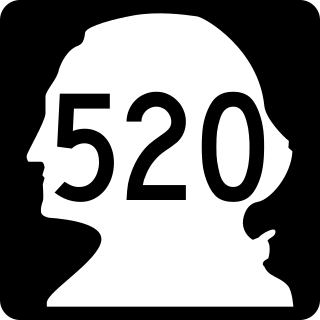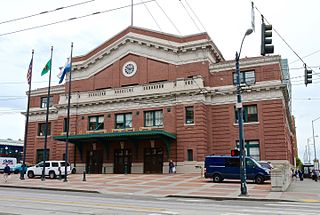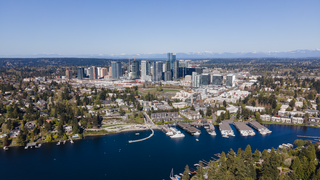
Redmond is a city in King County, Washington, United States, located 15 miles (24 km) east of Seattle. The population was 73,256 at the 2020 census, up from 54,144 in 2010.

Bellevue is a city in the Eastside region of King County, Washington, United States, located across Lake Washington from Seattle. It is the third-largest city in the Seattle metropolitan area and has variously been characterized as a satellite city, a suburb, a boomburb, or an edge city. Its population was 122,363 at the 2010 census and 151,854 in the 2020 census. The city's name is derived from the French term belle vue.

State Route 520 (SR 520) is a state highway and freeway in the Seattle metropolitan area, part of the U.S. state of Washington. It runs 13 miles (21 km) from Seattle in the west to Redmond in the east. The freeway connects Seattle to the Eastside region of King County via the Evergreen Point Floating Bridge on Lake Washington. SR 520 intersects several state highways, including Interstate 5 (I-5) in Seattle, I-405 in Bellevue, and SR 202 in Redmond.

Sound Transit (ST), officially the Central Puget Sound Regional Transit Authority, is a public transit agency serving the Seattle metropolitan area in the U.S. state of Washington. It operates the Link light rail system in Seattle and Tacoma, regional Sounder commuter rail, and Sound Transit Express bus service. The agency also coordinates the regional ORCA fare card system, which is also used by local transit operators. In 2017, Sound Transit services carried a total of 47 million passengers and averaged 157,000 riders on weekdays.

Transportation in Seattle is largely focused on the automobile like many other cities in western North America; however, the city is just old enough for its layout to reflect the age when railways and trolleys predominated. These older modes of transportation were made for a relatively well-defined downtown area and strong neighborhoods at the end of several former streetcar lines, now mostly bus lines.

Overlake is the name for a region comprising parts of eastern Bellevue and southern Redmond, Washington. It is in the vicinity of Microsoft's main corporate campus and is officially defined as a neighborhood consisting of the parts of Redmond lying south of Northeast 60th Street and between 148th Avenue Northeast and Bellevue-Redmond Road. The Overlake area, so named because it is located across Lake Washington from Seattle, straddles the boundaries of Bellevue and Redmond and is considered to have its own identity distinct from those of both cities.

Interstate 405 (I-405) is a north–south auxiliary Interstate Highway serving the Seattle region of Washington, United States. It bypasses Seattle east of Lake Washington, traveling through the Eastside area of King and Snohomish counties, providing an alternate route to I-5. The 30-mile (48 km) freeway serves the cities of Renton, Bellevue, Kirkland, and Bothell. I-405 terminates at I-5 in Tukwila and Lynnwood, and also intersects several major highways, including SR 167, I-90, SR 520, and SR 522.

Link light rail is a light rail rapid transit system serving the Seattle metropolitan area in the U.S. state of Washington. It is managed by Sound Transit in partnership with local transit providers, and consists of two non-connected lines: the 1 Line in King County, which travels for 25 miles (40 km) between Seattle and Seattle–Tacoma International Airport; and the T Line in Pierce County, which runs for under 2 miles (3.2 km) between Downtown Tacoma and Tacoma Dome Station. In 2022, the system had a ridership of 23,905,500, or about 75,000 per weekday as of the fourth quarter of 2022, primarily on the 1 Line, and runs trains at frequencies of 6 to 24 minutes.

Redmond Town Center is a mixed-use development and shopping center located in downtown Redmond, Washington. Owned and managed by Fairbourne Properties, Redmond Town Center has more than 110 shops, restaurants, lodging, and entertainment venues in an outdoor environment. It opened in 1997 on the site of a defunct municipal golf course along the north side of State Route 520.

The East Link Extension, also known as the 2 Line, is a future light rail line serving the Eastside region of the Seattle metropolitan area in the U.S. state of Washington. It will be part of Sound Transit's Link light rail system, running 14 miles (23 km) from west to east and serving 10 stations in Downtown Seattle, Mercer Island, Bellevue, and Redmond. The 2 Line is scheduled to open in 2024 and will continue into the Downtown Seattle Transit Tunnel and share stations with the 1 Line. A 3.7-mile-long (6.0 km) extension to Downtown Redmond with two additional stations is scheduled to open in 2025.

Safeco Plaza is a 50-story skyscraper in Downtown Seattle, Washington, United States. Designed by the Naramore, Bain, Brady, and Johanson (NBBJ) firm, it was completed in 1969 by the Howard S. Wright Construction Company for Seattle First National Bank, which relocated from its previous headquarters at the nearby Dexter Horton Building.

Downtown Bellevue is the central business district of Bellevue, Washington, United States. It is bounded by I-405 to the east, NE 12th Street to the north, 100th Ave NE to the west, and Main Street to the south, and covers an area of around 400 acres (160 ha). It is the second largest city center in Washington state, with more than 50,000 employees and 12,000 residents. Geographically centered near the heart of the Puget Sound region, downtown Bellevue is a regional growth center offering over 9 million square feet (840,000 m2) of Class A office space, various major retail and entertainment locations, more than 2,500 hotel rooms and almost 10,000 housing units.

U District station is a light rail station on the 1 Line of Sound Transit's Link light rail system in Seattle, Washington, United States. It is located in the University District neighborhood, near the University of Washington campus. The underground station has two entrances along Brooklyn Avenue Northeast at 43rd and 45th streets.

Issaquah Highlands is a planned community and mixed-use neighborhood in Issaquah, a suburb of Seattle, Washington, United States. The neighborhood, located northeast of downtown Issaquah at Grand Ridge on the Sammamish Plateau, was planned in the New Urbanism style and opened in 1998 after a decade of planning and construction.

The Eastside Rail Corridor, officially Eastrail, is a rail right of way where a rail trail has been under development in the Eastside suburbs of Seattle, Washington. The corridor follows the path of the former Woodinville Subdivision from Renton to the City of Snohomish at Snohomish Junction. As of 2017, the northern portion was still in operation by Eastside Freight Railroad.

Redmond Technology station, formerly Overlake Transit Center, is a bus station and future light rail station in Redmond, Washington, United States. The current bus station opened in 2002 and is located on the headquarters campus of Microsoft; it is served by Sound Transit Express and King County Metro.

The Spring District is a transit-oriented development and neighborhood that is under construction in Bellevue, Washington. The 16-block, 36-acre (15 ha) development is centered around the Spring District/120th station on the East Link Extension, a light rail line scheduled to open in 2023. It is located in the Bel-Red area between Downtown Bellevue and Redmond, currently used for light industry, roughly bounded on the west by 120th Avenue NE and the Eastside Rail Corridor rail trail, on the north by a King County Metro bus base, on the east by 124th Avenue NE, and on the south by NE 12th Street.

Marymoor Village station is a future Link light rail station near Marymoor Park in Redmond, Washington. The station is located along the south side of State Route 520 southwest of its interchange with State Route 202 near Downtown Redmond. It also includes a 1,400-stall park and ride in a garage built on the site.
Esterra Park is a transit-oriented development under construction in the Overlake area of Redmond, Washington. The 28-acre (11 ha), 3.0 million square feet (280,000 m2) project is near major regional shopping and employment centers and multiple modes of transportation, including the future Overlake Village light rail station scheduled to open in 2023. The Esterra Park campus is expected to be home to a combined 8,000 residents and workers.

Bellevue 600 is a future high-rise office building developed by Amazon in Bellevue, Washington, United States. It began construction in 2021 and is scheduled to be completed in 2024. The 43-story, 600-foot-tall (180 m) building would join 555 Tower as the tallest building in Bellevue. The project is located in Downtown Bellevue at the intersection of Northeast 6th Street and 110th Avenue Northeast, adjacent to the Bellevue Transit Center and a future Link light rail station. A second phase would construct a 27-story tower to the west, replacing an existing office building.






















